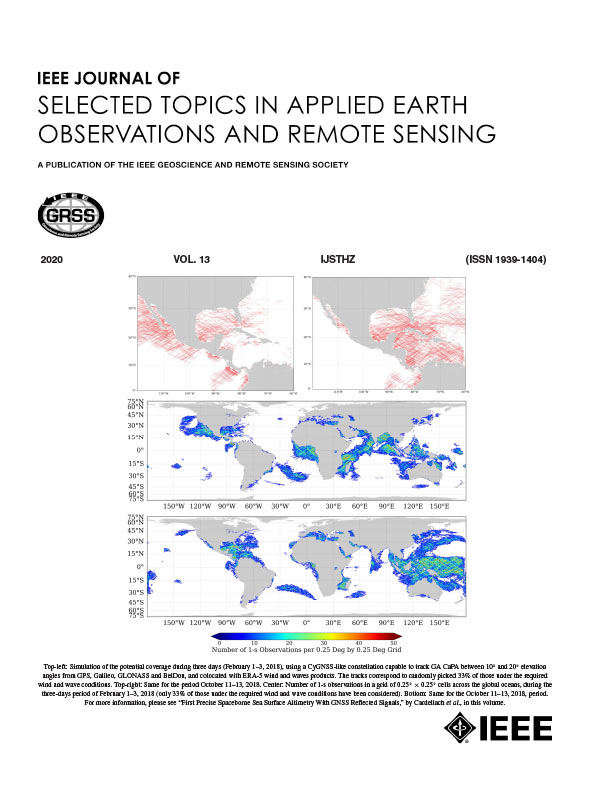Probability Prediction Network With Checkerboard Prior for Lossless Remote Sensing Image Compression
IF 4.7
2区 地球科学
Q1 ENGINEERING, ELECTRICAL & ELECTRONIC
IEEE Journal of Selected Topics in Applied Earth Observations and Remote Sensing
Pub Date : 2024-09-17
DOI:10.1109/JSTARS.2024.3462948
引用次数: 0
Abstract
Lossless remote sensing image compression aims to reduce the storage size of images without any information loss, ensuring that the decompressed image is identical to the original one. Most existing methods focus on lossy image compression that reduce the storage cost with certain data loss. It is challenging to perform lossless compression due to the very high-resolution images, long encoding–decoding time, and low compression efficiency. In this article, we propose a lossless compression framework that compresses remote sensing images in a coarse-to-fine manner. Specifically, checkerboard segmentation is applied on each image to generate six subimages from the main diagonal and counter-diagonal of each channel to maximally preserve the detail and structural information. The subimages from the main diagonal are initially compressed by a traditional compression method, while the subimages from the counter-diagonal are compressed channel by channel using our proposed probability prediction network (P2Net) and arithmetic coding with the previously encoded subimages from both the main diagonal and counter-diagonal as prior knowledge. The proposed P2Net consists of a upsampling module, a feature enhancement module, a downsampling module, and a probability prediction module to learn the discrete probability distribution of pixels. Lossless compression is conducted with arithmetic coding on the discrete probability distribution. To the best of our knowledge, this is the first deep learning-based lossless compression framework for three-channel remote sensing images. Experiments demonstrate that our framework outperforms the state-of-the-art methods and requires about 3.4 s to compress a 1024用于无损遥感图像压缩的棋盘格先验概率预测网络
无损遥感图像压缩的目的是在不丢失任何信息的情况下减少图像的存储空间,确保解压缩后的图像与原始图像完全相同。现有的大多数方法侧重于有损图像压缩,这种方法在降低存储成本的同时会造成一定的数据损失。由于图像分辨率非常高,编码-解码时间长,压缩效率低,因此进行无损压缩具有挑战性。在本文中,我们提出了一种无损压缩框架,以从粗到细的方式压缩遥感图像。具体来说,对每幅图像进行棋盘式分割,从每个通道的主对角线和反对角线上生成六个子图像,以最大限度地保留细节和结构信息。来自主对角线的子图像最初采用传统压缩方法进行压缩,而来自对角线的子图像则采用我们提出的概率预测网络(P2Net)和算术编码逐个通道进行压缩,并将先前编码的来自主对角线和对角线的子图像作为先验知识。所提出的 P2Net 由一个上采样模块、一个特征增强模块、一个下采样模块和一个学习像素离散概率分布的概率预测模块组成。通过对离散概率分布进行算术编码,实现无损压缩。据我们所知,这是首个基于深度学习的三信道遥感图像无损压缩框架。实验表明,我们的框架优于最先进的方法,压缩一幅1024美元/次, 文本{1024}\,\times$ 3的图像大约需要3.4秒,与JPEG XL相比效率提高了2.9%。
本文章由计算机程序翻译,如有差异,请以英文原文为准。
求助全文
约1分钟内获得全文
求助全文
来源期刊
CiteScore
9.30
自引率
10.90%
发文量
563
审稿时长
4.7 months
期刊介绍:
The IEEE Journal of Selected Topics in Applied Earth Observations and Remote Sensing addresses the growing field of applications in Earth observations and remote sensing, and also provides a venue for the rapidly expanding special issues that are being sponsored by the IEEE Geosciences and Remote Sensing Society. The journal draws upon the experience of the highly successful “IEEE Transactions on Geoscience and Remote Sensing” and provide a complementary medium for the wide range of topics in applied earth observations. The ‘Applications’ areas encompasses the societal benefit areas of the Global Earth Observations Systems of Systems (GEOSS) program. Through deliberations over two years, ministers from 50 countries agreed to identify nine areas where Earth observation could positively impact the quality of life and health of their respective countries. Some of these are areas not traditionally addressed in the IEEE context. These include biodiversity, health and climate. Yet it is the skill sets of IEEE members, in areas such as observations, communications, computers, signal processing, standards and ocean engineering, that form the technical underpinnings of GEOSS. Thus, the Journal attracts a broad range of interests that serves both present members in new ways and expands the IEEE visibility into new areas.

 求助内容:
求助内容: 应助结果提醒方式:
应助结果提醒方式:


